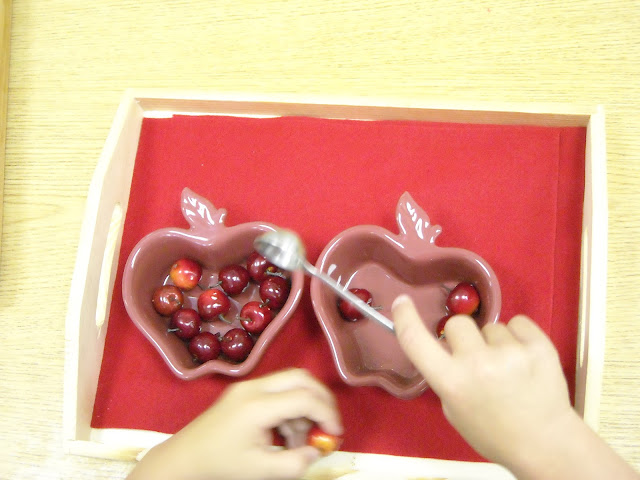I should mention this, that my teaching career was started with being an assistant infant/toddler teacher and this experience was an eye-opening experience for me. Unfortunately, I do not have my personal pictures to share with you but thank goodness for some beautiful blogs on Montessori infant/toddler training and Google that I can share my experience with the help of these pictures.
When I say eye-opening experience, it means that I had never seen a 6 month old drinking milk from a glass before, in fact, I never knew that it was physically possibly to carry a glass with those tiny little hands ! Yes, I witnessed it because I helped the child do it. Of course, we had everything to the size of all the infants, for example, little chairs, tables, utensils.
I think, it is the process you go through when you are living with your child and know your child. It was like, I was growing and learning with this particular child, we were like best friends. No matter if the child was just 6 months old, we were communicating with each other, there was a connection and that's what, I think, every child wants ! For me lesson learned - start early !
So, this experience opened my mind and made me realize that no child is too little to do anything. Thank goodness for the Montessori infant/toddler curriculum that they have it written, to start early with a child of 6 months old and above, with sitting on their cute chairs, stop drinking milk using their bottles and eat their food on the table. Well, it is a process, you have to believe in that this is possible.
I am emphasizing on the process because most of us expect results or look for results. This thing comes in our mind, say, "Hey, this happened with her child why not with my child!" We have to follow the child and we go through a phase or a time and that is also called a process. We are all growing and for every growth we need a motive/goal/dream/something to learn. I have friends and know some parents who have real hard time transitioning their children from bottle to the glass. In the end, they leave up to the school teacher to do that hard effort !!
I strongly suggest parents to try practising at home the same process too, by using infant size utensils and furniture, role modeling by giving examples of your self because they see you drinking milk from the glass. By the time, the child is 8 months old, s/he will be having fun being an independent and a happy being.
Start early !
When I say eye-opening experience, it means that I had never seen a 6 month old drinking milk from a glass before, in fact, I never knew that it was physically possibly to carry a glass with those tiny little hands ! Yes, I witnessed it because I helped the child do it. Of course, we had everything to the size of all the infants, for example, little chairs, tables, utensils.
I think, it is the process you go through when you are living with your child and know your child. It was like, I was growing and learning with this particular child, we were like best friends. No matter if the child was just 6 months old, we were communicating with each other, there was a connection and that's what, I think, every child wants ! For me lesson learned - start early !
 |
| While I googled for an image of a child drinking milk, I found this image and this little girl looks exactly the little one I helped then. Image courtesy- Montessori ici |
So, this experience opened my mind and made me realize that no child is too little to do anything. Thank goodness for the Montessori infant/toddler curriculum that they have it written, to start early with a child of 6 months old and above, with sitting on their cute chairs, stop drinking milk using their bottles and eat their food on the table. Well, it is a process, you have to believe in that this is possible.
I am emphasizing on the process because most of us expect results or look for results. This thing comes in our mind, say, "Hey, this happened with her child why not with my child!" We have to follow the child and we go through a phase or a time and that is also called a process. We are all growing and for every growth we need a motive/goal/dream/something to learn. I have friends and know some parents who have real hard time transitioning their children from bottle to the glass. In the end, they leave up to the school teacher to do that hard effort !!
I strongly suggest parents to try practising at home the same process too, by using infant size utensils and furniture, role modeling by giving examples of your self because they see you drinking milk from the glass. By the time, the child is 8 months old, s/he will be having fun being an independent and a happy being.
Start early !






























